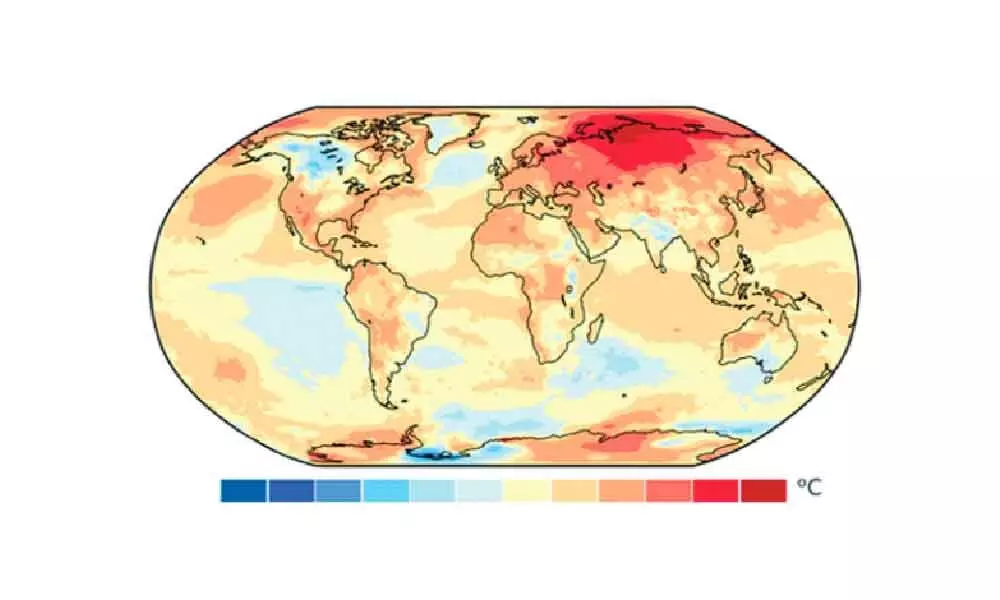2020 was one of three warmest years on record

2020 was one of three warmest years on record
The year 2020 was one of the three warmest years on record and rivalled 2016 for the top spot, indicating the pace of the "human-induced" climate change which is now as powerful as the force of nature
The year 2020 was one of the three warmest years on record and rivalled 2016 for the top spot, indicating the pace of the "human-induced" climate change which is now as powerful as the force of nature, the UN weather agency has said. All five datasets surveyed by the World Meteorological Organisation (WMO) concur that 2011-2020 was the warmest decade on record, in a persistent long-term climate change trend.
The warmest six years have all been since 2015, with 2016, 2019 and 2020 being the top three. The differences in average global temperatures among the three warmest years are indistinguishably small. The average global temperature in 2020 was about 14.9°C, 1.2 (± 0.1) °C above the pre-industrial (1850-1900) level.
"The confirmation by the World Meteorological Organisation that 2020 was one of the warmest years on record is yet another stark reminder of the relentless pace of climate change, which is destroying lives and livelihoods across our planet," Secretary-General António Guterres said. He pointed out that at 1.2 degrees of warming above pre-industrial levels, the world is already witnessing unprecedented weather extremes in every region and on every continent.
"We are headed for a catastrophic temperature rise of 3 to 5 degrees Celsius this century," he said. "Making peace with nature is the defining task of the 21st century. It must be the top priority for everyone, everywhere," he said. La Nina, which began in late last year, is expected to continue into the early-middle part of 2021.
La Nina refers to the large-scale cooling of the ocean surface temperatures in the central and eastern equatorial Pacific Ocean, coupled with changes in the tropical atmospheric circulation, namely winds, pressure and rainfall. It usually has the opposite impacts on weather and climate as El Nino, which is the warm phase of the so-called El Nino Southern Oscillation (ENSO).
"The exceptional heat of 2020 is despite a La Nina event, which has a temporary cooling effect," WMO Secretary-General Petteri Taalas said. La Nina and El Nino effects on average global temperatures are typically strongest in the second year of the event. "It is remarkable that temperatures in 2020 were virtually on a par with 2016, when we saw one of the strongest El Nino warming events on record," he added.
"This is a clear indication that the global signal from human-induced climate change is now as powerful as the force of nature," Taalas said. The extent to which the continued cooling effects of La Nina this year may temporarily diminish the overall long-term warming trend remains to be seen.
The WMO pointed to sustained heat and wildfires in Siberia, diminishing Arctic sea ice and record-breaking hurricanes in the Atlantic as being among the climate events that most stood out in 2020.
The UN weather agency said that temperature is just one climate change indicator. Greenhouse gas concentrations, ocean heat content, global mean sea level, sea ice extent and extreme events are also factors. The WMO's consolidated global temperature update incorporates information from five leading international sets of data. It also uses datasets that combine millions of meteorological and marine observations, including from satellites, with models to produce a complete reanalysis of the atmosphere.
"The combination of observations with models makes it possible to estimate temperatures at any time and in any place across the globe, even in data-sparse areas such as the polar regions," according to WMO. The Paris Agreement aims to limit global warming to well below 2°C, preferably to 1.5°C degrees, compared to pre-industrial levels.
However, the global average temperature in 2020 had already approached the lower limit of the temperature increase that the Agreement seeks to avert. Moreover, there is at least a one-in-five chance that the average global temperature will temporarily exceed 1.5 °C by 2024, according to?WMO's Global Annual to Decadal Climate Update, led by the United Kingdom's Met Office. The 2021 Met Office annual global temperature forecast also suggests that next year will again be one of the earth's hottest years












